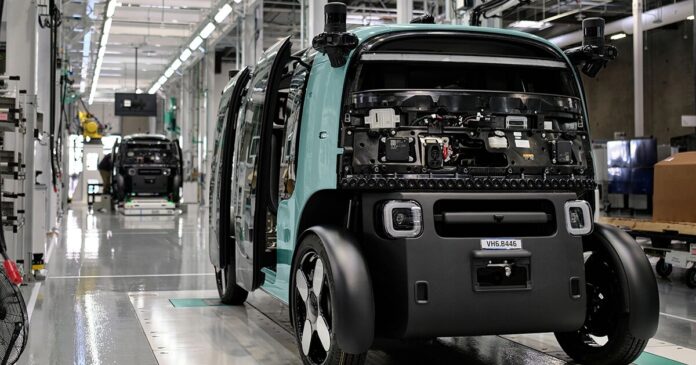Introduction to Zoox Robotaxis
Amazon subsidiary Zoox is gearing up for the commercial launch of its robotaxis in Las Vegas later this year. The company has recently opened its second production facility in Hayward, California, which will produce over 10,000 driverless four-passenger vans annually. This facility spans 220,000 square feet and will be responsible for assembling the robotaxis and conducting end-of-line testing before deploying the vehicles.
Production Facility and Process
The Hayward plant is equipped with a combination of human and robot workers. While there is no onsite welding or painting, the facility works with pre-manufactured components from suppliers. Robots are tasked with moving the robotaxis down the assembly line and applying adhesive to the vehicles’ surfaces. A video showcasing the production process provides a glimpse into the assembly of a Zoox taxi, including key steps such as:
- Assembling the steering-less, pedal-less carriage
- Installing interior parts and sensors for autonomous driving
- Calibrating the sensors
- Wheel and headlight alignment
- Stress testing the powertrain, brakes, and thermal systems
- Checking for leaks with a simulated rainstorm
- Quality inspection in a light tunnel
Features and Capabilities of Zoox Robotaxis
The Zoox robotaxi experience is designed to be similar to other ride-hailing services, where users can book a ride using an app and get picked up at their desired location. Each of the four carriage seats comes equipped with safety belts, a wireless phone charger, and zoned climate control. The vehicle features a screen on the side panel that displays the current route, time to arrival, and music controls. The robotaxis are designed to operate at a maximum speed of 45 mph and can handle rides in the rain and at night.
Testing and Launch Plans
Zoox has been testing its robotaxi on public roads in Las Vegas since June 2023 and has been picking up passengers at no charge through its early-access program. The company plans to launch paid public rides in a 5-mile radius around the Las Vegas Strip and surrounding areas later this year. Following the launch in Las Vegas, Zoox will introduce its early-rider program in San Francisco before expanding to other cities, including Austin, Texas, and Miami, Florida, in the next few years.
Competition in the Robotaxi Market
Zoox will soon be competing with other companies, such as Waymo, which has partnered with Uber to operate in several US cities. Lyft plans to enter the market in 2026, and Tesla is expected to launch its own robotaxi service, although it will initially be limited to company employees and invited guests.
Conclusion
With the opening of its second production facility and the upcoming commercial launch of its robotaxis in Las Vegas, Zoox is poised to make a significant impact in the autonomous vehicle market. The company’s focus on safety, comfort, and convenience is likely to appeal to users, and its expansion plans suggest a promising future for the robotaxi industry. As the market continues to evolve, it will be interesting to see how Zoox and its competitors navigate the challenges and opportunities of autonomous transportation.

